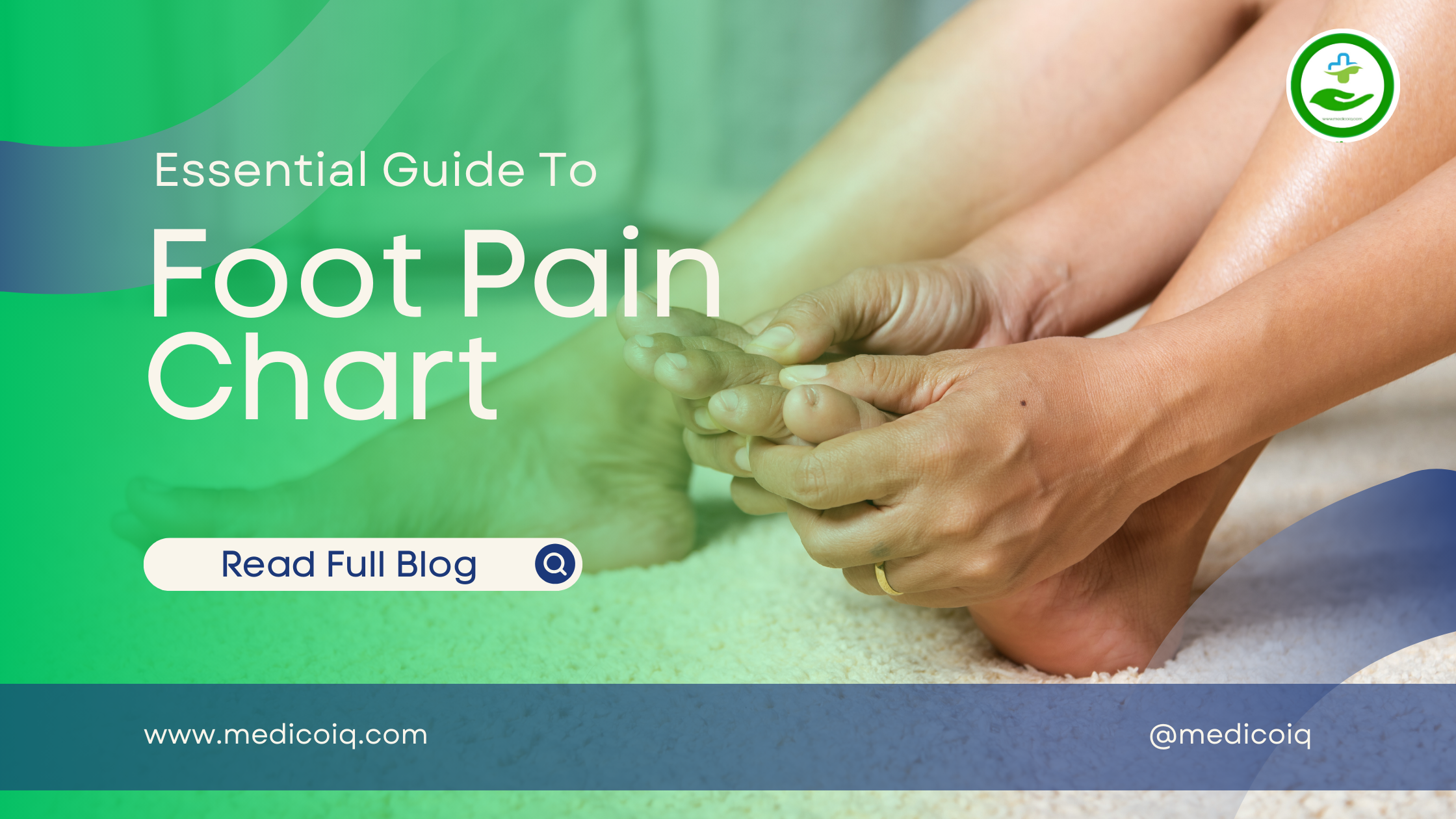Table of Contents
Foot pain chart can be a bothersome and distressing issue that affects people of all ages. The health of our feet plays a vital role in our overall well-being, as they support our entire body weight and allow us to perform daily activities.
This article will discover the common causes of foot pain and introduce you to the invaluable tool, the foot pain chart. Whether you are a medical student or seeking knowledge about foot pain, this comprehensive guide will provide valuable insights into managing and understanding foot pain through the top foot pain diagnosis chart.
The Foot Pain Chart: An Invaluable Tool
A foot pain chart is a visual representation of the various areas of the foot, divided into sections to help identify specific pain points. It serves as an essential tool for both individuals and healthcare professionals in diagnosing foot issues accurately.
Using the top foot pain chart, individuals can better communicate their symptoms to medical experts and make self-assessment more effective.
Understanding the Foot Pain Chart
The foot pain chart is designed to help individuals identify pain in specific areas of the foot, such as the forefoot, midfoot, or hindfoot. It provides a detailed anatomy of the foot, aiding in the proper communication of pain locations to healthcare professionals for accurate diagnosis and treatment.
How to Use the Foot Pain Chart
Using the foot pain chart is straightforward and can be done at home for self-assessment. By identifying the exact location of pain on the chart, individuals can track and document changes over time, helping healthcare professionals diagnose and manage foot conditions more effectively.

List of Foot Pain Chart
1. Plantar Fasciitis
Pain in the heel or arch of the foot caused by inflammation of the plantar fascia, a band of tissue that connects the heel to the toes. Pain is often worst in the morning.
Causes
- Overuse or repetitive strain on the plantar fascia
- Tight calf muscles
- Improper footwear,
- Obesity,
- High-impact activities
- Abnormal foot mechanics.
Treatment
- Rest and reduced activity.
- Stretching exercises for the calf and plantar fascia.
- Orthotic insoles or arch supports.
- Proper footwear with good arch support.
- Ice massage.
- Nonsteroidal anti-inflammatory drugs (NSAIDs).
- Physical therapy.
- Night splints.
- Corticosteroid injections (in severe cases).
- Shockwave therapy (in persistent cases)

2. Achilles Tendinitis
Pain in the Achilles tendon, which connects the calf muscles to the heel bone. It’s often due to overuse or strain and can result in pain at the back of the ankle.
Causes
- Overuse
- Sudden increases in activity
- Poor footwear
- Tight calf muscles
- Flat feet,
- Aging
Treatment
- Rest and reduced activity.
- Stretching exercises for the Achilles tendon.
- Heel lifts or orthotic insoles.
- Proper footwear with good support.
- Ice massage.
- NSAIDs.
- Physical therapy.
- Eccentric strengthening exercises.
- Corticosteroid injections (in severe cases).
- Extracorporeal shockwave therapy (ESWT).
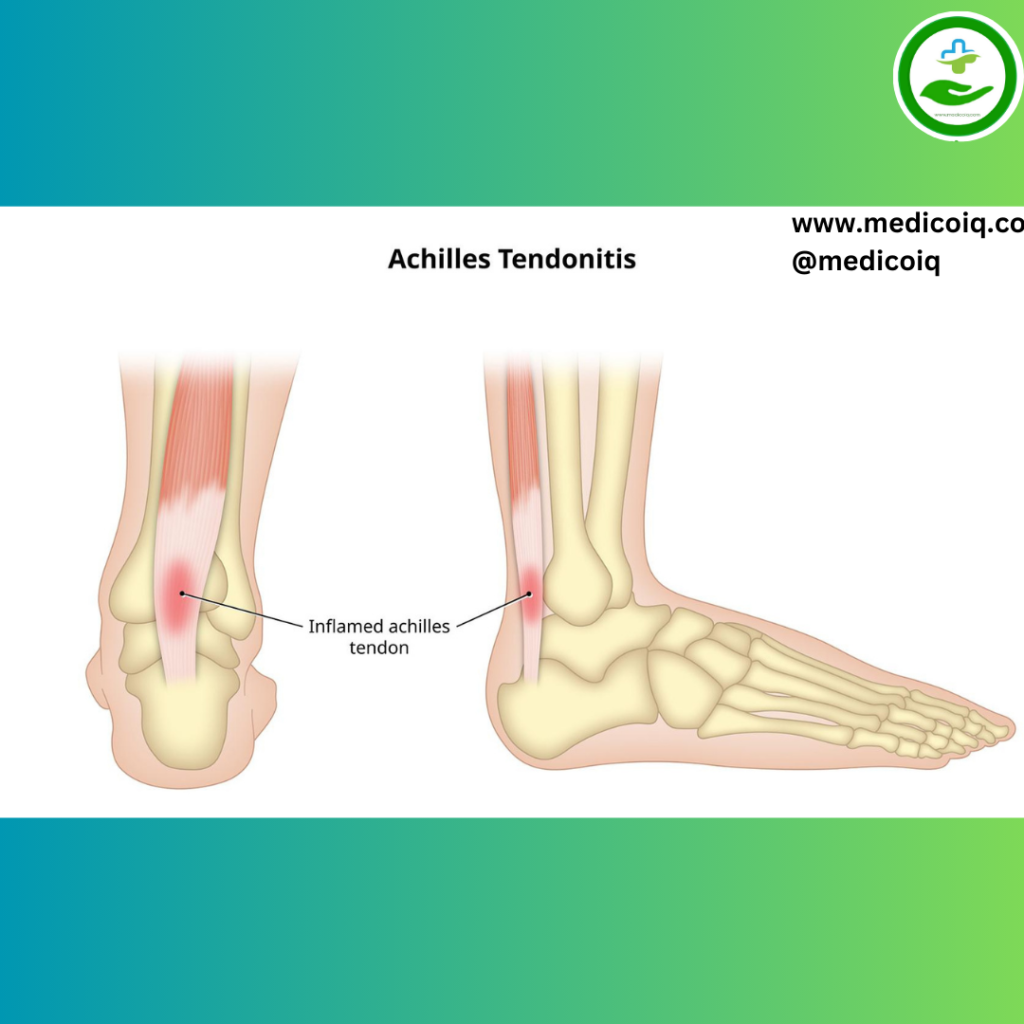
3. Metatarsalgia
Pain and inflammation in the ball of the foot, typically caused by excessive pressure on the metatarsal bones. High-impact activities or improper footwear can contribute to this condition.
Causes
- Excessive pressure on the metatarsal heads,
- Often due to high-impact activities
- Ill-fitting footwear
- Ffoot deformities, or aging.
Treatment
- Rest and activity modification.
- Orthotic insoles with metatarsal pads.
- Proper footwear with cushioning in the forefoot.
- Ice massage.
- NSAIDs.
- Padding or taping.
- Physical therapy.
- Corticosteroid injections (in severe cases).
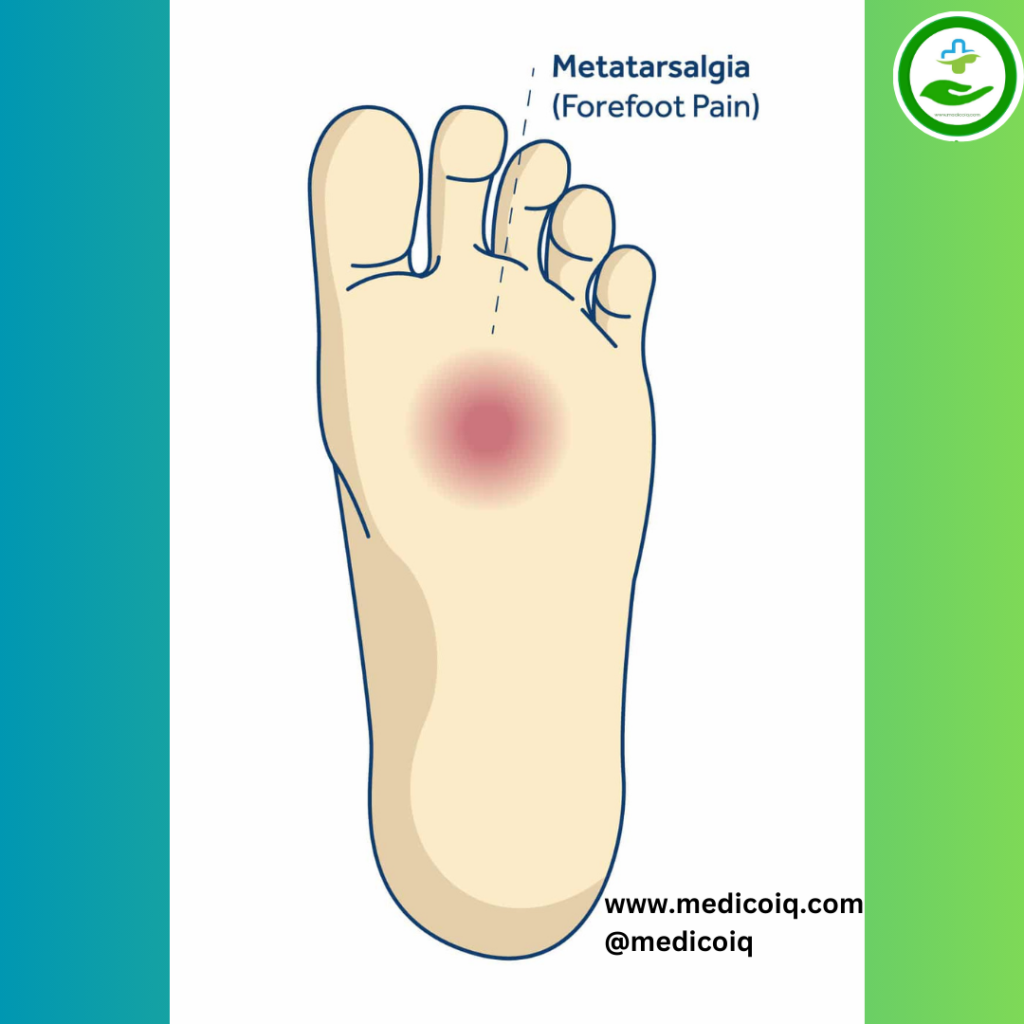
4. Bunions
Painful bony bumps that form on the joint at the base of the big toe. They can cause pain and affect the alignment of the toes
Causes
- Genetic predisposition
- Wearing tight or ill-fitting shoes
- Foot deformities
- Structural imbalances in the foot.
Treatment
- Wider, roomier footwear.
- Toe spacers or cushions.
- Orthotic insoles.
- Bunion pads or splints.
- NSAIDs.
- Physical therapy.
- Custom orthotics (in severe cases).
- Surgical correction (bunionectomy) for severe or painful bunions.
5. Ingrown Toenails
Pain and discomfort caused when the edge of a toenail grows into the surrounding skin. It can lead to infection if not treated properly.
Causes
- Improper nail trimming,
- Tight footwear
- Injury to the toe
- Genetic factors that affect nail shape.
Treatment
- Warm soaks.
- Gently lifting the ingrown edge.
- Antibiotic ointment.
- Proper nail trimming techniques.
- Wearing open-toed shoes.
- Surgical removal of the ingrown nail (in severe cases).

6. Morton’s Neuroma
A condition characterized by pain and numbness in the ball of the foot, often between the third and fourth toes, due to a thickening of nerve tissue.
Causes
- Compression or irritation of the interdigital nerve
- Often caused by tight footwear
- Hhigh heels,
- Repetitive stress.
Treatment
- Wider, cushioned footwear.
- Orthotic insoles with metatarsal pads.
- Metatarsal arch support.
- Steroid injections.
- Sclerosing alcohol injections.
- Physical therapy.
- Surgical removal (neurectomy) in severe or refractory cases
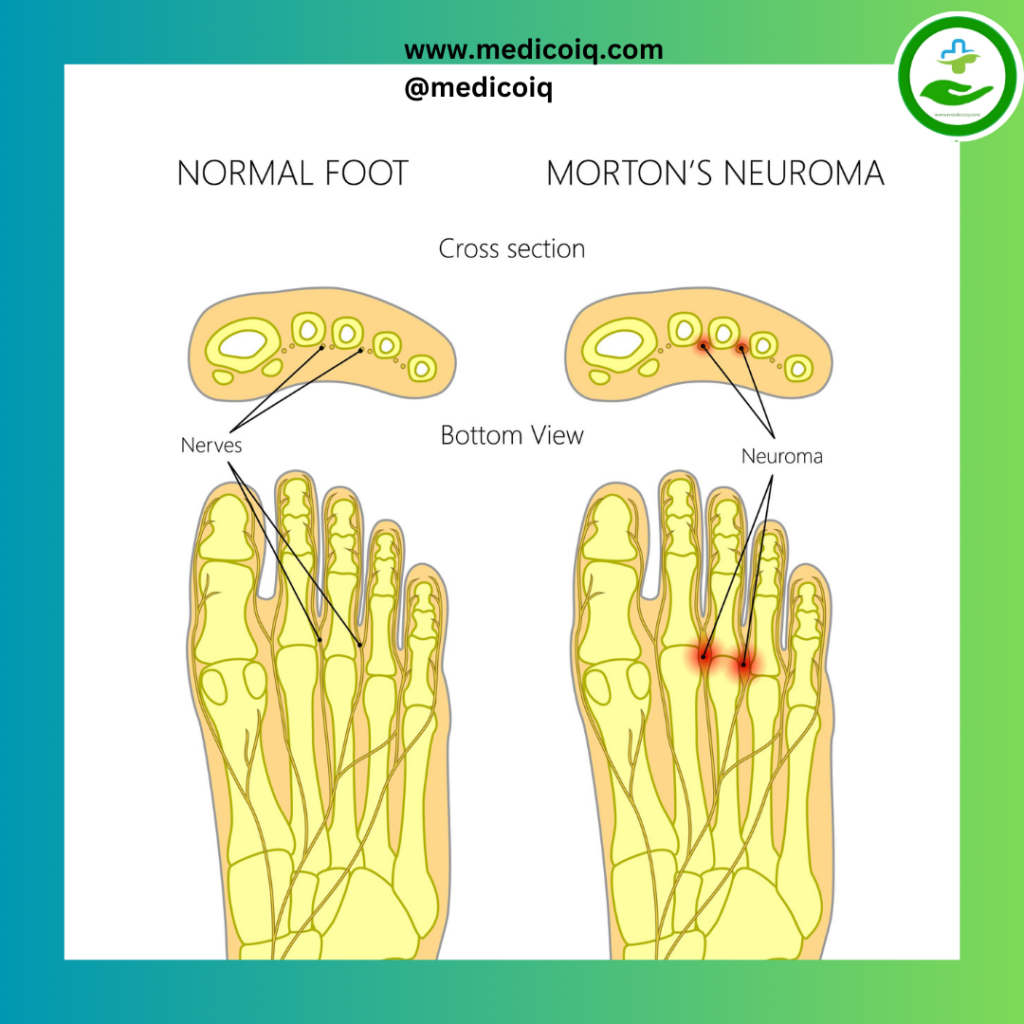
7. Hammer Toe
Toes that become bent at the middle joint, causing pain and discomfort. This condition can result from muscle imbalances and poorly fitting shoes.
Causes
- Imbalance in toe muscles
- Genetics
- Wearing tight shoes
- Conditions like arthritis.
Treatment
- Toe exercises.
- Toe splints or cushions.
- Proper footwear with a wide toe box.
- NSAIDs.
- Corticosteroid injections (inflamed joints).
- Surgical correction (hammertoe surgery) for severe deformities.

You Need To Know About– How Does Heal and Soothe Work for Pain Relief?
8. Gout
Intense pain, swelling, and redness in the joints, often in the big toe. Gout is caused by the buildup of uric acid crystals in the joints.
Causes
- Buildup of uric acid crystals in the joints
- Often triggered by a diet rich in purines
- Aalcohol consumption
- Dehydration
- Genetic factors.
Treatment
- Medications to reduce uric acid levels.
- Anti-inflammatory drugs (NSAIDs or colchicine) for pain and inflammation.
- Lifestyle and dietary changes to avoid triggers.
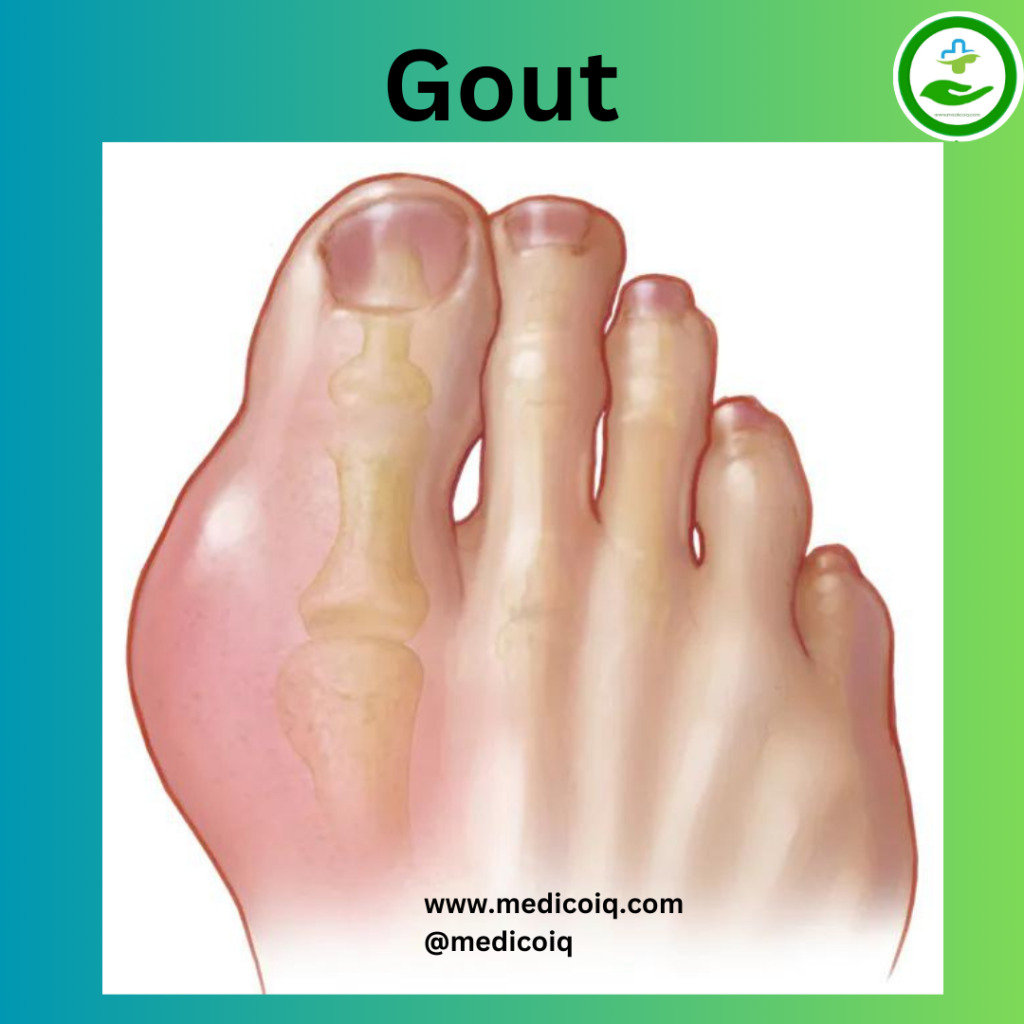
9. Stress Fractures
Hairline fractures in the bones of the foot, often due to overuse or repetitive stress. They can cause localized pain and swelling.
Causes
- Overuse
- Repetitive stress on bones
- Sudden increase in activity
- Inadequate rest periods.
Treatment
- Rest: Allow adequate time for the foot to heal by avoiding weight-bearing activities.
- Ice: Apply ice packs to the affected area to reduce swelling and alleviate pain.
- Compression: Use compression bandages or braces to provide support and minimize movement.
- Elevation: Elevate the foot to reduce swelling and promote blood circulation.
- Pain Medication: Over-the-counter pain relievers can help manage pain and inflammation.

10. Flat Feet (Pes Planus)
A condition in which the arches of the feet collapse, leading to pain and discomfort in the feet and lower legs.
Causes
- Genetic factors
- Weakened arch-supporting muscles
- Injury
- Conditions that affect muscle and tendon function.
Treatment
- Orthotic Inserts: Use custom or over-the-counter arch supports to provide proper foot alignment.
- Foot Exercises: Strengthen the muscles and improve arch support through specific exercises.
- Supportive Footwear: Wear shoes with proper arch support and cushioning.
- Physical Therapy: Consult with a physical therapist for targeted exercises and stretches.

11. Tarsal Tunnel Syndrome
Similar to carpal tunnel syndrome in the wrist, this condition involves compression of the tibial nerve in the ankle, leading to pain, tingling, and numbness in the foot.
Causes
- Compression of the tibial nerve or its branches
- Often due to injury
- Inflammation
- Systemic conditions like diabetes.
Treatment
- Rest and Immobilization: Reduce activity and use braces or splints to immobilize the foot.
- Anti-Inflammatory Medications: Nonsteroidal anti-inflammatory drugs (NSAIDs) can help alleviate pain and swelling.
- Physical Therapy: Stretching and strengthening exercises to improve foot function.
- Corticosteroid Injections: Injections may be considered for severe cases to reduce inflammation.
12. Rheumatoid Arthritis
An autoimmune disease that can cause inflammation, pain, and deformity in the joints, including those in the feet.
Cause
- Autoimmune disorder causing inflammation in the joints
- Including those in the feet.
Treatment
- Medications: Disease-modifying antirheumatic drugs (DMARDs) and anti-inflammatory medications.
- Physical Therapy: Joint protection techniques and exercises to maintain mobility.
- Assistive Devices: Use of orthopedic shoes, braces, or walking aids for support.
- Intra-Articular Injections: Corticosteroid injections for localized pain relief

13. Neuropathy
Nerve damage that can result in tingling, burning, and shooting pain in the feet. It is often associated with diabetes.
Causes
- Diabetes,
- Alcohol abuse
- Infections
- Certain medications
- Other systemic conditions that damage nerves.
Treatment
- Blood Sugar Control: For diabetic neuropathy, maintaining stable blood sugar levels is crucial.
- Medications: Prescription medications to manage pain and symptoms.
- Nerve-Stimulating Techniques: Transcutaneous electrical nerve stimulation (TENS) for pain relief.
- Lifestyle Modifications: Foot care, proper footwear, and avoiding factors that exacerbate symptoms.
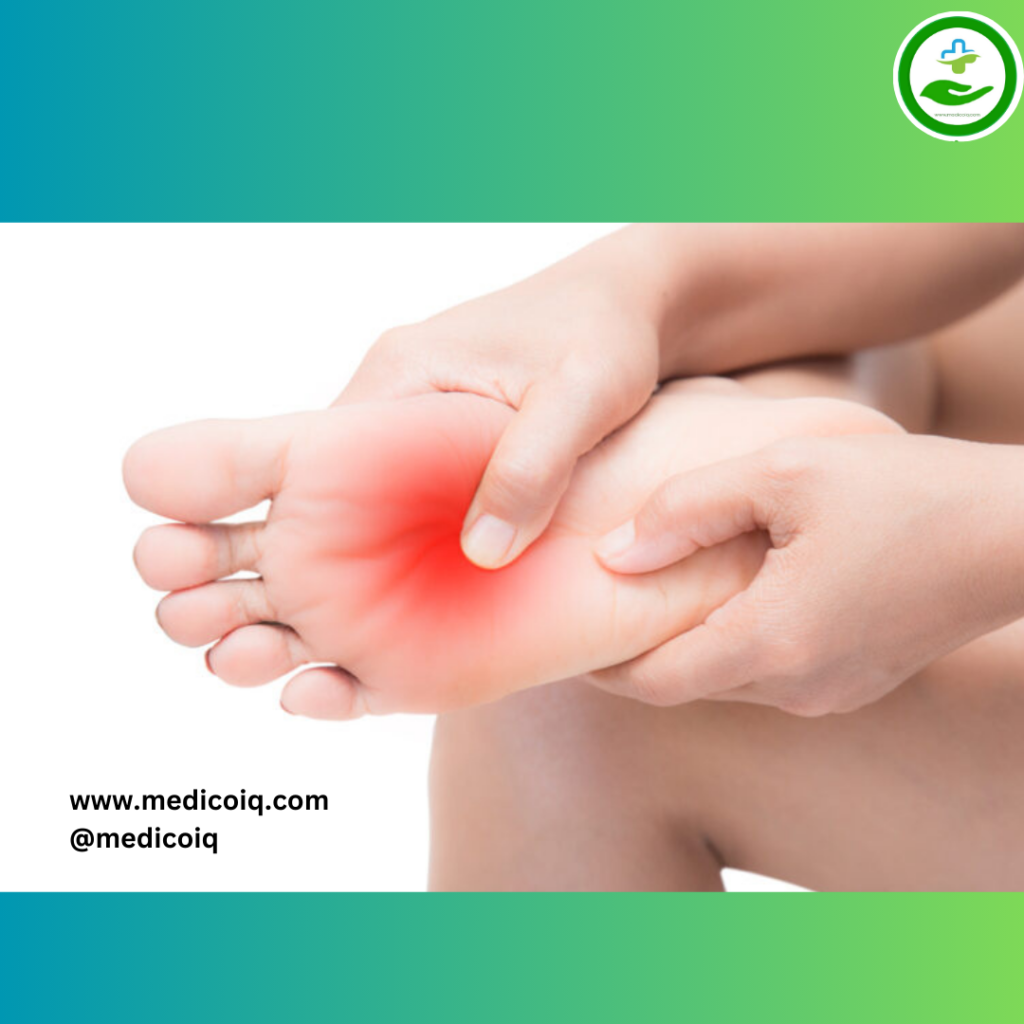
14. Sesamoiditis
Inflammation of the sesamoid bones under the big toe joint, leading to pain and difficulty walking.
Causes
- Overuse
- Repetitive stress
- Trauma to the sesamoid bones under the big toe.
Treatment
- Rest: Minimize weight-bearing activities to allow the sesamoid bones to heal.
- Ice: Apply ice to reduce inflammation and pain.
- Cushioned Footwear: Use shoes with extra padding to relieve pressure on the sesamoid bones.
- Orthotic Inserts: Custom or over-the-counter inserts to provide additional support.

15. Heel Spurs
Bony growths on the heel bone that can cause sharp, stabbing pain in the heel, especially when walking or standing.
Causes
- Calcium deposits on the heel bone
- Often associated with chronic plantar fasciitis
- Excessive strain on the foot.
Treatment
- Stretching Exercises: Calf and plantar fascia stretches to reduce tension on the heel.
- Orthotic Inserts: Supportive inserts to improve foot mechanics and reduce strain.
- Footwear Modifications: Choose shoes with proper arch support and cushioning.
- Physical Therapy: Stretching and strengthening exercises to address the underlying causes.

16. Corns and Calluses
Thickened, hardened areas of skin on the feet that can cause discomfort or pain, especially when walking.
Causes
- Friction or pressure on the skin
- Often due to improperly fitting shoes
- Bony prominences
- Abnormal gait.
Treatment
- Foot Soaks: Soften the skin through warm water soaks.
- Pumice Stone: Gently exfoliate the affected area to reduce thickness.
- Moisturizing: Apply moisturizer to keep the skin soft and prevent recurrence.
- Proper Footwear: Ensure shoes fit well and do not contribute to friction.

Back Foot Pain Chart
Heel Spurs
Description: Heel spurs are bony growths that often develop in response to chronic plantar fasciitis. They can cause additional pain and discomfort in the heel.
Symptoms: Pain in the heel that may worsen with weight-bearing activities.
Treatment: Treatment is usually focused on addressing the underlying plantar fasciitis. Surgery to remove the heel spur may be considered in rare cases.
Metatarsalgia
Description: Metatarsalgia involves pain and inflammation in the ball of the foot, typically under the metatarsal heads (the bones behind the toes).
Symptoms: Pain and a burning sensation in the forefoot, often aggravated by walking or standing.
Treatment: Rest, metatarsal pads, orthotic insoles, proper footwear with cushioning, ice massage, NSAIDs, physical therapy, and, in severe cases, corticosteroid injections.
Sesamoiditis
Description: Sesamoiditis is the inflammation of the sesamoid bones, which are small bones located beneath the big toe joint.
Symptoms: Pain and tenderness under the big toe joint, particularly when walking or bearing weight on the foot.
Treatment: Rest, cushioning, metatarsal pads, orthotic insoles, proper footwear, ice massage, NSAIDs, and physical therapy. In severe cases, corticosteroid injections may be considered.
Tarsal Tunnel Syndrome
Description: Similar to carpal tunnel syndrome in the wrist, tarsal tunnel syndrome involves compression of the tibial nerve in the ankle, leading to pain and discomfort on the underside of the foot.
Symptoms: Tingling, burning, or shooting pain on the bottom of the foot, often radiating to the toes.
Treatment: Rest, orthotic devices, supportive footwear, NSAIDs, physical therapy, and, in some cases, corticosteroid injections. Surgical decompression may be necessary in severe cases.
Foreign Body
Description: Sometimes, pain on the bottom of the foot may be caused by a foreign object, like a splinter or glass shard, embedded in the skin.
Symptoms: Sharp, localized pain that may worsen with pressure on the affected area.
Treatment: Carefully remove the foreign body if visible and accessible. Clean the wound and apply an antiseptic. Seek medical attention if you can’t remove the object or if the wound becomes infected.
Front Foot Pain Chart
Front foot pain can be caused by various conditions affecting the structures on the front part of the foot. Here are details about common causes of front foot pain:
Metatarsalgia
Description: Metatarsalgia involves pain and inflammation in the ball of the foot, typically under the metatarsal heads (the bones behind the toes).
Symptoms: Pain and a burning sensation in the forefoot, often aggravated by walking or standing.
Treatment: Rest, metatarsal pads, orthotic insoles, proper footwear with cushioning, ice massage, NSAIDs, physical therapy, and, in severe cases, corticosteroid injections.
Morton’s Neuroma
Description: Morton’s neuroma is a condition characterized by pain and numbness in the ball of the foot, often between the third and fourth toes, due to a thickening of nerve tissue.
Symptoms: Sharp or burning pain in the forefoot, sometimes described as walking on a pebble or a folded sock.
Treatment: Rest, proper footwear with a wide toe box, metatarsal pads, corticosteroid injections, sclerosing alcohol injections, and, in severe cases, surgical removal of the neuroma.
Capsulitis
Description: Capsulitis involves inflammation of the ligaments (capsules) surrounding the joints in the ball of the foot, often the second toe joint.
Symptoms: Pain and tenderness, typically in the second toe joint, sometimes accompanied by swelling.
Treatment: Rest, metatarsal pads, orthotic insoles, proper footwear, ice massage, NSAIDs, and physical therapy.
Turf Toe
Description: Turf toe is a sprain of the ligaments around the big toe joint, often caused by hyperextension of the toe.
Symptoms: Pain, swelling, and limited motion in the big toe joint.
Treatment: Rest, ice, compression, elevation (RICE protocol), taping or splinting, NSAIDs, and physical therapy.
Hallux Rigidus
Description: Hallux rigidus is a form of degenerative arthritis affecting the big toe joint, causing stiffness and pain.
Symptoms: Limited range of motion, pain, and stiffness in the big toe joint, often aggravated by walking and wearing tight shoes.
Treatment: Proper footwear with a stiff sole, orthotic insoles, physical therapy, NSAIDs, corticosteroid injections, and, in severe cases, surgical intervention.
Toenail Issues
Description: Conditions like ingrown toenails or fungal infections can cause pain and discomfort in the front part of the foot.
Symptoms: Pain, redness, and swelling around the affected toenail.
Treatment: For ingrown toenails, conservative measures include warm soaks, proper nail trimming, and antibiotic ointment. Fungal infections may require antifungal medications.
Sesamoiditis
Description: Sesamoiditis is the inflammation of the sesamoid bones, which are small bones located beneath the big toe joint.
Symptoms: Pain and tenderness under the big toe joint, particularly when walking or bearing weight on the foot.
Treatment: Rest, cushioning, metatarsal pads, orthotic insoles, proper footwear, ice massage, NSAIDs, and physical therapy. In severe cases, corticosteroid injections may be considered.
Seeking Professional Help
Understanding when to seek professional medical care. is essential for effective foot pain management. Podiatrists and orthopedic specialists are trained to diagnose and treat various foot conditions. A comprehensive foot examination, including medical history and physical examination, is crucial for accurate diagnosis.
Preventive Measures for Foot Pain
Preventing foot pain starts with choosing appropriate footwear that provides proper support and cushioning. Additionally, engaging in foot exercises and stretches can strengthen the feet and reduce the risk of injuries.
Proper foot care and hygiene are also essential for maintaining foot health.
Home Remedies for Foot Pain
For mild foot pain, several self-care measures can be implemented at home. These include rest, applying ice to reduce inflammation, using compression, and elevating the foot to alleviate swelling.
Over-the-counter pain relievers can be used for temporary relief but should be used cautiously and as directed.
When Foot Pain Requires Urgent Attention
Certain signs indicate the need for urgent medical attention. These include severe pain, inability to bear weight on the foot, signs of infection, or symptoms of vascular issues such as cold or discolored toes.
Foot Pain in Different Age Groups
Foot pain can present differently in different age groups. Children and adolescents may experience growing pains or sports-related injuries, while adults and seniors may face age-related foot conditions.
Tailoring foot care based on age-related factors can help promote foot health.
Conclusion Of Foot Pain Chart
In conclusion, understanding foot pain chart and its causes is essential for maintaining optimal foot health. Utilizing the foot pain chart and seeking professional medical advice when needed can greatly aid in accurately diagnosing and managing foot conditions.
Remember to prioritize foot health through proper foot care, suitable footwear, and regular self-assessment using the top foot pain chart. With the perfect knowledge and proactive measures, you can enjoy pain-free and healthy feet, ensuring overall well-being and mobility for years to come.
FAQs Of Foot Pain Chart
What is the Foot Pain Chart?
The Foot Pain Chart is a visual representation that categorizes various foot pain conditions and their corresponding areas of discomfort. It helps individuals identify potential foot problems and understand common causes.
How can I use the Foot Pain Chart?
Simply locate the area on the chart where you’re experiencing pain, and identify the associated foot condition. This can serve as a starting point for discussions with healthcare professionals about possible causes and treatments.
What are some common foot pain conditions depicted on the chart?
The chart includes conditions such as plantar fasciitis, Achilles tendinitis, bunions, stress fractures, flat feet, and more. Each condition is associated with specific areas of the foot.
What causes foot pain?
Foot pain can have various causes, including overuse, improper footwear, genetic factors, injuries, underlying medical conditions (such as arthritis or diabetes), and structural abnormalities in the foot.
When should I seek medical attention for foot pain?
It’s advisable to consult a healthcare professional if foot pain persists, worsens, or is accompanied by other concerning symptoms such as swelling, redness, numbness, or difficulty walking.

